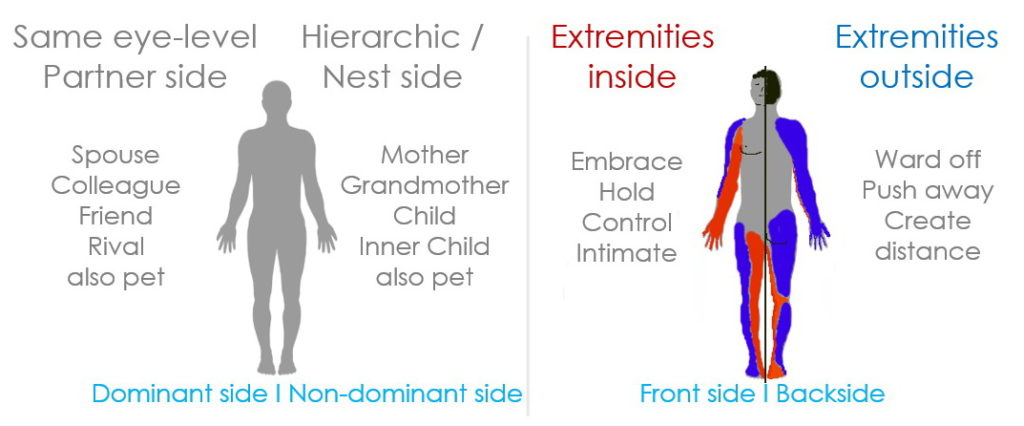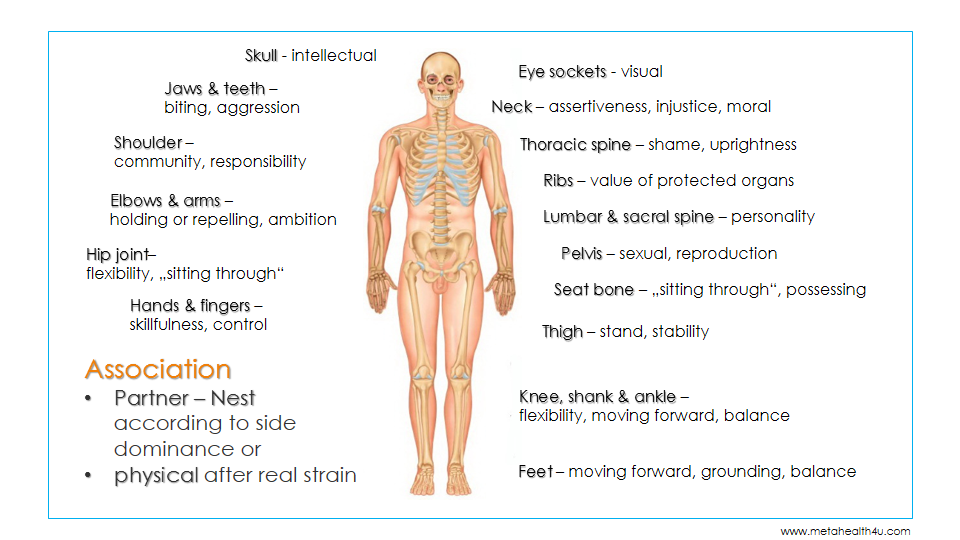The skeleton serves three major functions:
- Shape & support
The skeleton provides the framework which supports the body and maintains its shape. The pelvis, associated ligaments and muscles provide a floor for the pelvic structures. Without the rib cages, costal cartilages, and intercostal muscles, the lungs would collapse.
- Movement
The joints between bones allow movement, some allowing a wider range of movement than others, e.g. the ball and socket joint allows a greater range of movement than the pivot joint at the neck. Movement is powered by skeletal muscles and guided by ligaments. Muscles are attached at various sites on bones, usually leading over one or more joints. Muscles, bones, and joints provide the principal mechanics for movement, all coordinated by the central nervous system.
- Protection
The skeleton and it´s muscular and fibrous components protect many vital organs:
-
- The skull protects the brain, the eyes, and the middle and inner ears.
- The vertebrae protect the spinal cord.
- The rib cage, spine, and sternum protect the human lungs, human heart and major blood vessels.
- The clavicle and scapula protect the shoulder.
- The ilium and spine protect the digestive and urogenital systems and the hip.
- The patella and the ulna protect the knee and the elbow respectively.
- The carpals and tarsals protect the wrist and ankle respectively.

META-Organs
We distinguish several organs and organ tissues in the muscloskeletal and locomotor system based on their unique stress-emotion-belief associations and brain relay locations.
- Bones (CM -/+): Self-worth concerning stability and endurance
- Periosteum sensitivity (CC -/+): Unjust contact/separation, indignation
- Cartilage (CM -/+): Self-worth concerning connection and friction
- Ligaments (CM -/+): Self-worth concerning guidance, stability and elasticity
- Tendons (CM -/+): Self-worth concerning (muscular) performance
- Muscle (CM -/+): Self-worth concerning (muscular) performance
- Muscle Fascia (CB & MB +/-): Muscular protection, integrity
- Motoric Innervation (CC -/+): Ability to act/react
- Fatty Tissue (CM -/+): Self-worth concerning buffering and protection
Fatty tissue, cartilage, tendons & ligaments consist of connective tissue with relays in the Cerebral Medulla. Muscle fascia, joint capsules, bursae & periosteum, consist mainly of connective tissue with relays in the Cerebellum.
Skeletal System – Conflict Associations
The skeletal system in general related to self-worth, strength, stability and movement. In our analysis we need to pay attention to handedness and localization:
- Dominant Side: on the same eye level, like partner, rival
- Non-dominant Side: on different eye levels, like child, mother, inner child
- Localization: Area we were touched, affected (physically or emotionally), or that was tense at the time of the trauma.

More specifically each part of our skeletal system has unique stress trigger associations:

- Cranial Bone: Moral-intellectual self-devaluation.
- Feeling dumb and unintelligent.
- Humiliation, injustice, oppression, discord, infidelity, insincerity, dishonesty, fraud.
- Eye Socket (bony orbits): Self-devaluation in respect to the eyes or the environment of the eyes
- Jaw – Upper/Lower: Not being able to get, bite or hold
- unexpressed anger. Holding back.
- Teeth Dentin: not being able to bite, defend oneself:
- front teeth, cannot bite off
- canine teeth, cannot get hold of, hold on to
- molar teeth, cannot grind/crush/break down the chunk or problem
- Spinal column: Deep personality traumas related to something that is very important for the person, e.g. “My life’s work has been destroyed…” ”Due to my disease, I can’t do anything and I’m not worth anything.”
- Cervical Spine, Neck: Not feeling free. Moral self-devaluation due to moral injury, infringement of human ethics for example: humiliation, injustice, oppression, discord, infidelity, insincerity, dishonesty, subjection (bow to someone). False price or limiting beliefs relating to morality or expectations.
- Thoracic Spine: Central personality devaluation due to too much weight/pressure from above
- Feeling humiliated or defeated.
- Often guilt and shame
- Local devaluation due to impairments or diseases in the thoracic cavity
- Breastbone (sternum): Feeling not worthy or strong enough in relation to our chest, breasts or heart.
- Ribs: Not being able to protect:
- heart or lungs
- Self-devaluation regarding breasts because operation or insults
- Not being able to protect someone, surrogate conflict
- Shoulders: Not being a good mother or partner. Feeling too much weight on shoulders.
- Arms: Cannot embrace, hold on, throw out, kick away, defend or attack. Not satisfied ambitions.
- Right-handed men can use their left arm as a so-called shield arm, which is competent for the defense when being attacked, while the right, stronger arm tends to be the attacking arm.
- Elbows: Cannot hold onto something or someone. Overstraining of arm. Unsatisfied ambitions.
- Hands: Inability to hold something with hands, manual clumsiness
- Fingers: Clumsiness, feeling of having done something wrong or treated somebody badly. Failed at a task involving hands or detailed skills (perfectionist). Examples for possible finger associations:
- Thumb: Holding on, steering, direction, will power
- Index finger: Power, blame, pointing something out
- Middle finger: Spiritual connection, touching or sexual context
- Ring finger: Love, marriage, relationships
- Little finger: Communication, secrets we can’t share
- Lumbar spine: Central Personality Devaluation. Not being able to cope with pressure. Not being able to define self. Not following one’s passion.
- Tailbone (Coccyx): Central self-devaluation
- due to disorders in the anal area, e.g. anal abscesses or haemorrhoids
- not able to keep the balance
- lack of grounding
- Ileosacral joints: Central and deep personality devaluation
- Often sexuality-related issues
- Wings of ilium: Self devaluation theme, with respect to pregnancy, the concerned woman isn’t able to get pregnant because of the size of her pelvis
- Pelvic and Pubic bone: Sexual self-devaluation because of infertility, premature ejaculation or other sexual stress triggers
- Ischium: Not being able to wait or possess something
- Acetabulum (Pelvis cotyloid cavity): Can’t hold argument or stand against rival, boss or other dominant person
- Femoral necks: Not being able to endure or prevail
- Legs: Cannot stand or deal with a situation. Not being able to balance, jump, kick or take a break.
- Knee: Not being stable or flexible enough. Not satisfied ambitions. Can’t run, jump or kick.
- Achilles tendon: Not being fast enough
- Feet: Self-devaluation about movability, foot dexterity or the disability to do something with feet:
- Not being able to run, dance, play or keep balance in life
- Not being able to fend off or kick someone or something away
- Toes: Lack of grounding/roots.
- Big toe: Cannot keep the balance
- Heels: Not able to control the situation, to brake, to crush
Joints consist of at least 2 bones which communicate and cooperate with each other. Therefore, joint problems are about conflicting motives, ineffective cooperation or overload.
The text links lead into the META-Wiki in MHI’s members portal
Study biological programming and how it can relate to mental and physical dis-ease, to help the World be META-healthy!
pictures: MHI, metahealth4u.com
